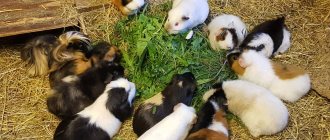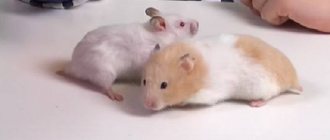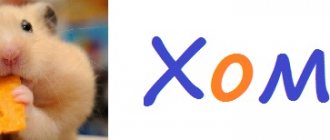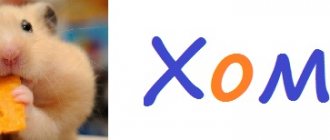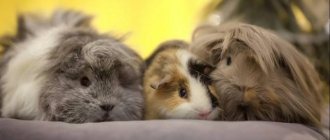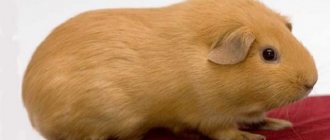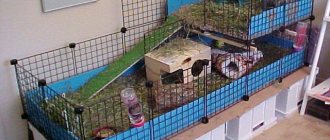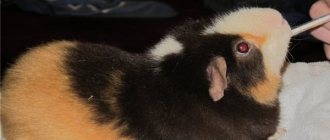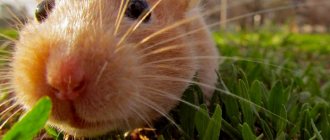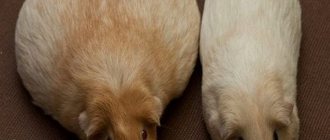- home
- Guinea pig
- Guinea pig behavior
02/18/2019 All owners adore their pets, especially watching their funny antics. It is a known fact that many animals sleep quite funny. The behavior of ferrets, dogs and cats in their sleep is known to many, but you can also learn something interesting about guinea pigs.
How and in what poses
The guinea pig is a pack animal. In its natural habitat, it is surrounded by strong predators; it is forced to hide in burrows, look for food, relying on the protection of adult males. The constant subconscious expectation of an attack naturally influenced the animal’s lifestyle, which is followed by pets.
When adapting to a new place of residence, a rodent may not sleep for several days. This is a completely natural reaction of a rodent to an unfamiliar environment, smells, frightening sounds, etc. From the new environment, the rodent becomes stressed and tries to hide in a shelter, in the darkest corner.
During the first days of getting used to new living conditions, the animal should not be disturbed without reason. You must add water and add food carefully, without making sudden movements, while at the same time affectionately addressing your pet by name.
The length of your guinea pig's sleep will gradually return to normal. Usually a calm animal falls asleep gradually. At the initial stage, the animal sits on its hind legs, slowly relaxes and lies down on the floor. However, at first, pigs are still wary of their owner, as evidenced by quivering ears and wide open eyes. The animal will be able to fall asleep only after completely calming down.
The more a pet gets used to a new place, the more fun it becomes and the more relaxed it feels. In everyday life, sleeping pigs take the following positions:
- lying on your side, with your paws tucked close to your body (or, alternatively, stretched out along the body), with your eyes closed;
- on the back;
- on the belly.
But the position when a guinea pig sleeps with its eyes open means excessive concern. If your pig is often found in uncomfortable positions, this is a reason to consult a veterinarian. This may be caused by the pet being unwell, or by some hidden injury.
When a guinea pig sleeps, it happens that it twitches its paws. Maybe she's having troubled dreams. To calm the animal, you need to slowly cover its nose with your palm. The familiar smell of a beloved owner will undoubtedly calm the pet.
Recommendations
Pets are most often purchased at the request of children. A child needs communication with living nature. Psychologists and teachers believe that caring for a pet, empathy, and the emotions that a child receives when interacting with it help develop the best human qualities. An animal at home becomes an incentive to understand the world around us. Responsibility and respect for nature are fostered.
Regardless of who you choose, parents must follow a few rules:
- explain that a hamster or guinea pig is not a toy for a child, but a living creature that has its own needs, its own character; talk about the characteristics of pets, lifestyle, care rules so that the child understands what can be done and what cannot be done, and why; to be aware that, no matter how old the child is, the responsibility for the purchase lies with the adult: he must monitor compliance with the rules of care and the health of the animal.
Communication with a pet, be it an active hamster or a calm guinea pig, should bring positive emotions to both the child and the adult. And joint care brings parents and children closer together.
Schedule
Guinea pigs are very active diurnal animals. These are quite nimble animals, despite their corpulent dimensions and impressive shape. The sleep period is short-term and lasts about 8–10 minutes. The total amount of sleep per day lasts about 4–6 hours.
Basically, the daily routine of rodents is quite consistent with the standard human one. During the day there is quite business activity, and at night it is time for sleep and rest. A characteristic feature of pigs is that they eat in small portions, but quite often. A pig can go to the bowl about 80 times a day. So the animal is characterized by noisy night feasts, which can disturb household members from sleeping.
In turn, the pig itself sleeps extremely lightly. Therefore, you should not disturb her before bed with loud noises, etc.
It happens that the animals’ daily routine changes, the period of sleep and wakefulness shifts. It’s not scary; it’s easy to correct your pet’s behavior if you shift the meal time. However, this must be done very carefully, since fluffies are very sensitive to any changes.
Record copies
Among the popular breeds of rodents there are real record holders in length and weight category. Let's find out how big a guinea pig of popular breeds grows to.
The tortoiseshell with white "Cake" is a relatively young breed bred by English breeders. The “cakes” crossed inside the breed delight the eye with their bright colors and impressive dimensions.
The average length of the body reaches 35 cm, and weight up to 1.6 kg. At the same time, the rodent is very active and inquisitive.
- A large guinea pig is the English Rex, the ancestor of many varieties. And to match the name of the breed, it is truly royal in size. At a young age, the development of cubs differs from the basic parameters, and the piglet’s maturation ends closer to two years. By maturity the animal grows up to 45 cm.
- Kui is the absolute champion among the guinea pig species. Small kui at birth weigh about 200 grams, and the weight of an adult pet reaches 4 kilograms, with a body length of 50 cm. Despite their gigantic size, these rodents are more susceptible to stress than others and are not very talkative.
We create comfortable conditions for your pet to sleep
Despite their relative unpretentiousness, pigs still need a comfortable living environment. They need bedding in the cage to sleep on, as well as houses and play tunnels to be able to hide. Comfortable conditions give pets the feeling of security they need.
When arranging a home for your furry friend, you should comply with some conditions:
- The cage should be located away from noisy household appliances, as well as from drafts and direct sunlight.
- The room temperature should be comfortable (18–23 °C).
- The minimum dimensions of a cage or terrarium for a pig are 30x40x50 cm.
- The cage must be cleaned several times a week.
- Play and exercise with your pet regularly.
Only in comfortable conditions will the pet feel at home, be able to fully relax and delight the owner with funny pranks.
Disease Prevention
Timely vaccination is the key to the longevity of any animal kept in captivity. Scheduled administration of vaccines builds the pig’s immunity and helps cope with parasites, viruses, and bacteria. From birth, pigs are vaccinated against worms and diseases that are registered in the region of residence. There are diseases that lead to premature death of pigs. Veterinarians call rickets dangerous. This disease affects the entire body of the piglet. The cardiovascular system and organs of the musculoskeletal system suffer.
To reduce the likelihood of diseases, animals are provided with optimal living conditions, checked for the presence of worms, dewormed in a timely manner, and treated for infectious and viral diseases.
The life of pigs is also extended in other ways. Boars are castrated, they live longer after castration. The number of pregnancies in sows is monitored. Bearing and feeding offspring exhausts the body. On a farm and a private farmstead, the life of meat piglets lasts 7-9 months; tallow piglets are sent for slaughter later, after 10 months. Breeding boars and sows are kept for 5-6 years. Under optimal conditions, pigs raised not for slaughter live for several decades.
What time do rodents go to bed?
Guinea pigs sleep at night and are awake during the day. The pet's daily routine corresponds to the owner's routine. Pigs often go to sleep at the same time as their owner. But you still need to be prepared for the fact that the sleep phase of pigs is shorter than that of humans. Therefore, they wake up at night to go about their business, drink, eat, and maybe play.
The owner must be very attentive to the pet’s sleep and rest. When the animal is sleeping, but the owner is not, then you should mind your own business and walk around the apartment, making as little noise as possible - the pet wakes up from the slightest rustle.
It should be noted that pigs are very pedantic; they are comfortable living under conditions of a once and for all established schedule.
What does the size of the animal indicate?
The following factors influence the size of a guinea pig:
Why does the owner need to know the normal size of the pet? First of all, height and weight indicate the health status of the animal. Knowing the normal dimensions of a pig also helps you navigate correctly when buying a pet. Based on this indicator, one can judge the estimated age and purity of the animal’s breed.
Next, we will take a closer look at the factors that influence the height and weight of guinea pigs.
How big does a male guinea pig grow? Adult males can reach a body length of up to 35 cm. They weigh up to 1.5 kg. Mature females are usually much smaller, their height is no more than 25 cm, and their weight rarely exceeds 1 kg.
Sleep duration
So how long do guinea pigs sleep? This question is very interesting for novice owners. During the period of adaptation to a new place, the sleep patterns of animals can be very unique. Until the animal gets used to its new home and feels completely safe, it will try to sleep as little as possible.
Guinea pigs can rest fully only after making sure that nothing threatens them. The total duration of the animal's sleep periods is only 4–6 hours a day. It is noteworthy that the entire dream is divided into several parts. During the night, the animal falls asleep several times, the longest period of one-time rest is 15 minutes.
After being awake, the animals do not immediately fall asleep again. They can devote some time to their own business: eat, drink water, and the quickest ones can play.
Also watch the video of a guinea pig sleeping.
Keeping a hamster
Let's figure out how a hamster differs from a guinea pig. Its lifespan is about two years. With proper care – 3-3.5 years. The rodent is small in size. The largest varieties reach 15 cm, dwarf varieties - 4-8 cm. Accordingly, they need less living space.
Hamsters, unlike pigs, are nocturnal. They are very mobile and need special devices to maintain motor activity, for example, a running wheel.
Owners may not like the night fuss and noise of a rotating wheel when their furry pet wants to go for a run. For normal life, he needs to cover 1-2 km a day.
Not all hamsters like to be held. It's better to explain this to your child. They bite much more often than marine ones, for which this is only a way to show that you have hurt them.
Do guinea pigs hibernate?
Guinea pigs are not hibernating mammals. The natural habitat of these rodents is warm southern countries, so the animals do not need to take shelter from the bitter cold. Only slightly reduced activity and the desire to warm up are echoes of the need for hibernation.
But a sudden prolonged sleep indicates some kind of disease in the animal and signals the need to consult a veterinarian.
Knowing the pet's sleep and rest habits, the owner is able to provide the pet with comfortable living conditions. No matter what concerns the owner may have, he must give his furry friend as much attention as possible. And then the animal will begin to completely trust you, will sleep on the owner’s lap, closing its eyes and completely entrusting its life to it, giving friendship for a long time.
General interpretation
The guinea pig is a species of domesticated rodent. In nature, they are very active, clean, social and peaceful. They do not like being alone, so they are constantly looking for a suitable mate. Looking after and taking care of each other is one of the fundamental features of these animals. Personifying an active, current position, they are very proactive and prolific. Females have a unique specialty - to resolve their unnecessary pregnancy or preserve the cubs, carrying them inside themselves for the most suitable option for childbirth.
For the dreamer, such a symbol can predict a lot of exciting and pleasant things. It is important that the rodent in a dream is placed favorably towards you, without showing any anger. The color of the animal is also of great importance for a positive interpretation. The brighter it is, the more joy, fun and happy events you can expect.
The guinea pig is a sign of hard work, benevolence, sociability and collectivism. It can reflect the current bustle, activities inconspicuous to others, some strangeness, emotionality from time to time, debauchery and dissatisfaction.
For ladies who dream of expecting their pregnancy, a guinea pig can signify the long-awaited conception and successful resolution of childbirth. For those ladies who are looking for a companion, such a vision can be a harbinger of a happy meeting with their lover
This person will be a very worthy choice, he will support you in every possible way, show his attention and care
Quite often, this little beast is dreamed of by those who give themselves one hundred percent to labor-intensive work. Sometimes the result of the sleeper’s labor is not immediately noticeable. But if the dreamer goes all the way towards his goal, he will achieve a lot.
This pet symbolizes perseverance and determination for those who take their first steps in business at a young age.
Courage mixed with timidity and caution is inherent in such people. They know what they want and how to achieve it, but they are held back by distrust of those in power. For lonely people, feeling a shaggy animal on your lap that purrs and snores sweetly is a good symbol
This symbolizes a change in your mood and attitude towards the world and people around you. Your gaze has become more open and trusting to those whom you were previously wary of. Peace, tranquility and tranquility will come in your soul, you will experience the happiness of being yourself
For lonely people, feeling a shaggy animal on your lap, purring and snoring sweetly, is a good symbol. This symbolizes a change in your mood and attitude towards the world and people around you. Your gaze has become more open and trusting to those whom you were previously wary of. Peace, tranquility and tranquility will come in your soul, you will experience the happiness of being yourself.
For married people who are experiencing a crisis in their marital relationship, such a plot will serve as a hint at the next step in life with their spouse, where there will again be love, awareness and harmony.
Why else do you dream about a guinea pig?
- to feed the beast - in reality to bring upon oneself streams of various benefits and wealth;
- cleaning a cage for rodents means doing charity and mercy. Your main current goal may be to help the needy and unhealthy;
- snow-white with blue eyes - you will actually experience a lot of positive feelings;
- smooth and please your pet - get a decent reward for a labor-intensive and creative process;
- to see a dead woman - to interrupt and spoil the plans of ill-wishers;
- to tame a feral pig - to be able to solve all your problems, get rid of credit debts, restore your reputation and good name;
- Taking something skinny and ugly from a pet store is a good symbol. This promises success and good profits in any business you undertake. Moral satisfaction and pride in what you have made will go beyond the limit of what is permissible;
- catching a fleeing animal is a symbol of lost profits. You were given a chance or a real opportunity to change your life, but you chose a different path, which you will later regret;
- dreamed of a brutal animal - be prepared for troubles and small dilemmas.
Methods for determining age
There are several ways to determine the age of a guinea pig. You can focus on body weight and parameters, lifestyle (slowness or activity) and other external signs.
Body weight and size
Up to 10 weeks of life there are no significant deviations between the body weight of males and females. A significant upward difference in weight in “boys” becomes noticeable after 10 weeks and older. Also, the physiological parameters of guinea pigs, for example, the ratio of age, height and body weight, directly depend on the quality of care, the built-up nutrition system and the breed of rodents.
The average size of males is 30-35 cm, females - 20-25 cm. The increase in body weight after 22 weeks decreases and stops at the age of 12-14 months. The weight of an adult guinea pig ranges from 700 to 1800 g (the average for males is 1500 g, for females 1200 g).
Behavioral features
When comparing the behavior of young and older individuals, significant differences can be noticed.
A young rodent is characterized by the following behavioral features:
- high physical activity and curiosity;
- sniffs previously uneaten food and chews it with interest;
- communicates with people and is always happy to communicate;
- plays a lot and actively explores the “possession”.
Activity decreases after 4-5 years of the animal’s life, which gradually becomes slow. At this stage, mature guinea pigs prefer familiar, favorite food, without showing noticeable interest in unfamiliar food. They behave apathetically and spend more time hibernating or sitting huddled in a corner.
Condition of the skin and coat
The way a rodent looks externally is directly affected by care and nutrition. But young individuals still have more elastic and clear skin without peeling and redness. The only exception to the rule is a sick animal, but in addition to the unhealthy appearance of the skin, other symptoms indicate its illness: lethargy, loss of appetite, tremors in the body.
The fur of young rodents is glossy and has a bright and rich color (sometimes including several different shades). As the animal grows and ages, the fur falls out, thins, becomes dull, and the color fades, although the animal does not have any health problems. It may also be that the shine of the coat is lost due to the fact that an older animal cleans itself less often compared to a young animal.
Breeders from England determine the age of a guinea pig by the amount of hair on its ears. They believe that the less there is in these areas, the older the animal.
Condition of teeth, paws and claws
The more carefully you care for your pet, the better it will look - that’s a fact. For example, if you don’t trim a guinea pig’s claws, it will gnaw off the front ones itself, but not enough of the back ones, so as the animal grows older, they grow more and more. In pet stores, animals’ claws are usually not trimmed or treated, which means that if they are very long and curled, it is a mature individual.
The main characteristics by which you can determine that a guinea pig is still young:
- not long and not deformed claws of neat shape and uniform color;
- healthy white teeth, not damaged or crooked. The animal does not disdain food with a solid structure;
- by looking at the paws of a rodent, you can tell whether the animal is young or elderly. In aging animals, the fingers bend and thicken, especially on the hind limbs.
During the period of senile changes, a rodent's teeth wear down, become yellow, and are covered with a dark plaque. The claws become rough, and with loss of normal mobility and poor care, they become deformed. If such signs are observed, then the animal is already 5 years old, or even more.
In very old individuals, teeth shift and eating becomes difficult, and sometimes impossible. In this case, you have to constantly feed the guinea pig with liquid food using a syringe.
A guinea pig's teeth grow throughout its life at a rate of 2-4 mm per week, so rodents grind them down daily.
